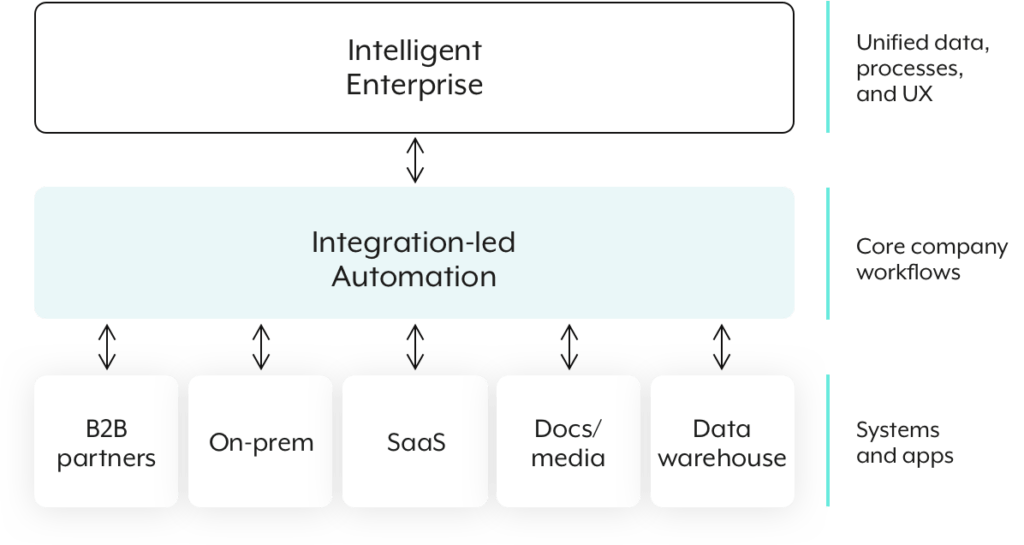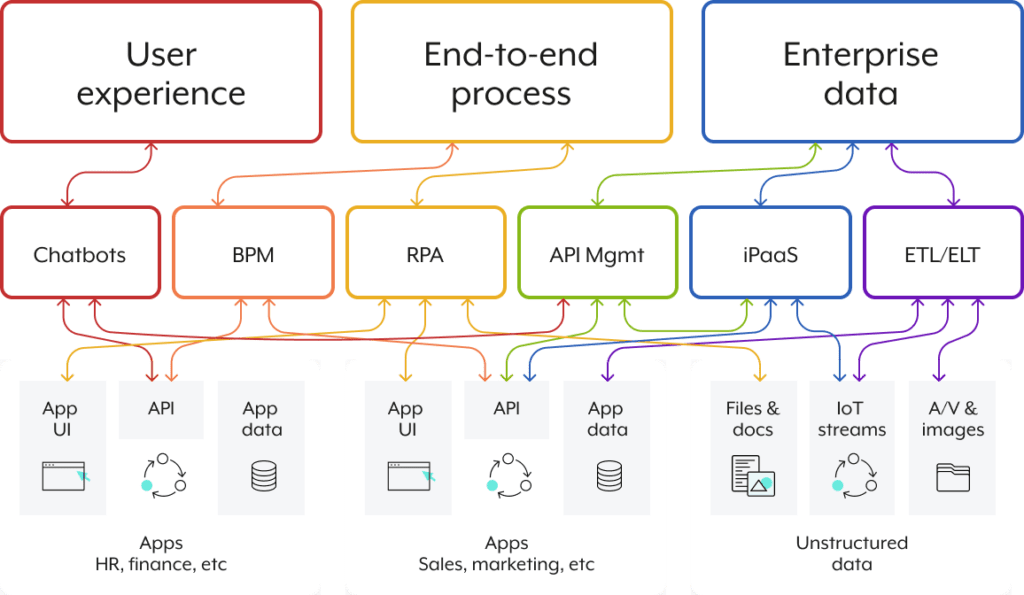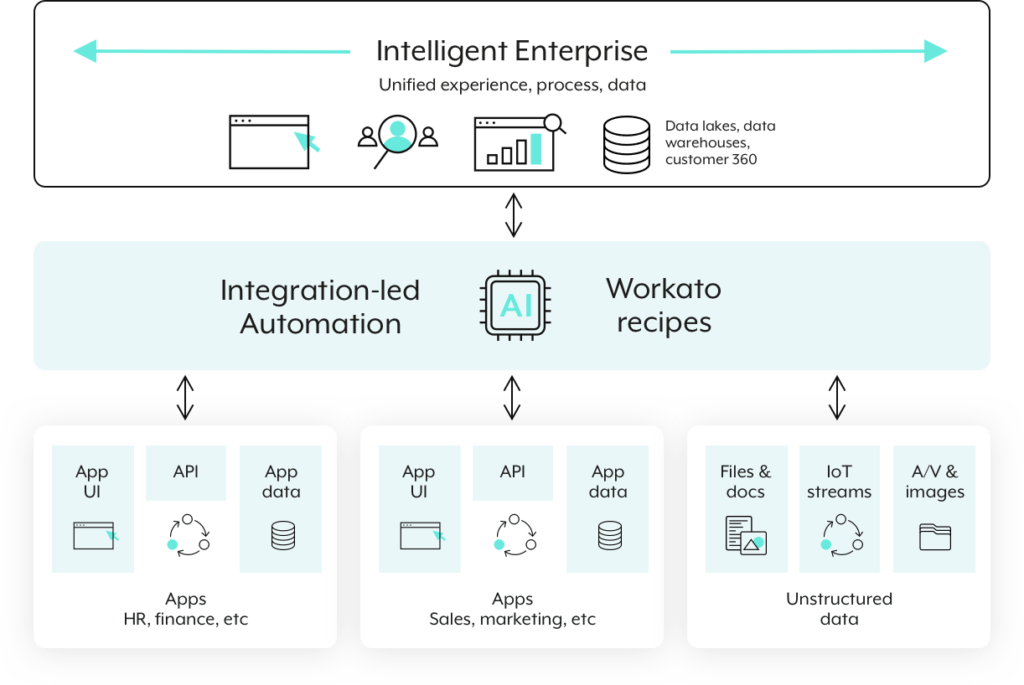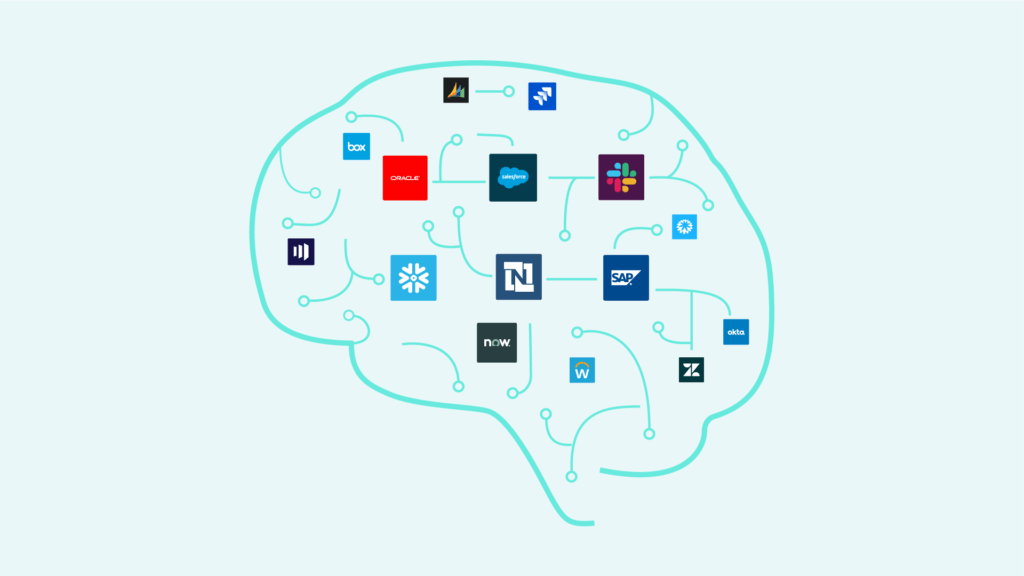Today, we announced $110M in Series D funding at a $1.7B valuation to automate the core operating workflows of companies. The round is led by Altimeter and joined by Insight Partners and our existing investors, Battery and Redpoint.
We now have over 7,000 customers and our business is three times larger than at the time of our Series C a year ago. In a space as ‘real-world’ as automation, everything we’ve learned that really matters comes from working with our customers and partners. We are incredibly grateful to you!
We also still have the $70M we raised in our Series C. So why did we choose to raise additional capital now?
With this new funding, we can accelerate our vision and lead the creation of a new category we refer to as Integration-led Automation. An Integration-led Automation platform automates the core operating workflows of organizations. The name is apt, because a modern automation platform must integrate and unify workflows across applications, data and your teams.

Workato: The OS for Enterprise-Wide Automation
But this category name alone does not fully capture the far-reaching impact that a unified platform like Workato can have on an enterprise’s ability to digitally transform and become an intelligent enterprise. The last year has forced companies to accelerate their digital transformation, not just within discrete business units but in the core business itself. There is an urgent need for a new layer of enterprise software, essentially an OS for enterprise-wide automation, to rapidly reimagine, automate, and transform the core operating flows of companies. Such a platform must be no-code/low code so everyone business and IT can automate, as automation has to be a team sport to scale.
We see Workato as that OS for enterprise-wide automation. Workato was built from the ground up to automate these core operating flows of a business, which cover all facets – data, process and UX integration – in one platform, and the last few years have demonstrated that our best customers are using us to transform their core business. “Recipes,” a critical concept in Workato, directly describes these flows in plain English (no-code), so they can be automated, monitored and transformed easily by IT and business teams.
Sharing the ride with our customers through 2020
Early on in the pandemic, I was talking to the CIO of a large ride sharing company who is also a great customer. Their core ride sharing business was impacted by the lockdowns. At the same time, they saw major new opportunities with other services, like delivering restaurant meals, groceries, and financial services. But they had to move at warp speed to meet the market demand, while at the same time enabling their team to be able to work fully remotely.
He described how they needed to retool their entire internal work operations, from onboarding new service providers, streamlining financial operations, and logistics, to customer experience and employee work experience. He told me that Workato was key to this retooling as it allowed them to automate workflows across their business apps and service providers. He wanted to make sure that we would be there to support him in this important initiative. Of course we were, and were gratified to play a small but key role in transforming their business.
Similarly, a major national shoe retailer that had shut down all stores and filed for bankruptcy, came out of their restructure 100% digital. They were able to achieve this in a matter of months with Workato and other tools. They too had to reimagine, redefine, and implement completely new core operating workflows across all of their systems and people.
We saw this pattern again in many other industries: a large financial, retirement, investment and insurance customer, a restaurant point-of-sale customer, a corporate travel customer, and many others chose to double down on automation-at-scale to fundamentally transform their businesses and get on top of the challenges and opportunities presented to them in 2020.
For these companies and many more, Workato is functioning as that OS for enterprise wide automation. It allows for agility, provides speed to go-live, and enables the team you already have to create the web of integration-led automation that is required for enterprise-wide digital transformation.
Real digital transformation has new requirements
Real digital transformation is not just about building a new website or letting employees chat on video. It is about transforming the very core of how you run your business.
To achieve this level of business transformation has always been very hard and much too slow. Here’s why:
- Companies are drowning in fragmented data, business processes, and UX because of the huge growth in business apps and cloud technologies.
- The apps alone aren’t enough. 90% of how companies actually work is not captured in the apps they use. It is captured in the core operating flows of how they operate internally to actually ‘Get the Job Done’ i.e to deliver the products and services their customers hire them to do, as Clayton Christensen defines it.
What differentiates one company from another is not the apps they use – they all mostly use the same kinds – it is these unique end-to-end flows that deliver the products and experiences their customers love. There is no single platform that defines or automates these flows and each is somewhat unique reflecting the company. Such flows are often hard to see, but are a critical part of an organization’s unspoken culture and matter profoundly in how they operate. - These core operating flows described above, need an integrated approach to the automation of their data, process, and UX. Today you are forced to use multiple tools resulting in parts of these flows being implemented piecemeal in different tools that don’t talk to each other. When you have a problem with a busted order where do you go? Is it a data issue? A broken process? Or did the notifications to escalate exceptions get stuck somewhere? It is in these gaps that both IT and business suffer. This is our opportunity. We solve this fundamental pain that exists in any successful business.
To recap: you need one platform that captures all your data, business processes, and UX so you can ‘see’ holistically what is happening, troubleshoot it, and fix it quickly. Further, when you want to improve your core operating flows, or even completely rethink entire processes, you can do this in one place, rather than doing multiple sub-projects in different tools, with uncertain outcomes.
To understand the nature of this unified-platform better, let’s dive in a bit into these flows and the kind of platform required to automate them.
Related: 4 ways to implement cloud integration
What does a unified platform for Integration-led automation look like?
Core operating flows describe how a company works internally through their unique end-to-end flows (across apps, data, and teams) that deliver the products and experiences their customers love. There are hundreds of these flows that happen across every department of the company.
For instance, when an order is placed by a consumer to buy a PS5 or a business signs up for Coupa’s procurement system the company’s core operating flows begin and a huge list of actions must occur. Of course, the new customer data needs to be synced between CRM, financial and other systems. But it also has to go through a full business process which includes the following and is not limited to:
- Approvals
- Provisioning of the customer
- Logistics around fulfillment of the order
- Revenue recognition
- Capturing feedback from the customer and taking action based on the feedback
- Errors or exceptions, like dropped orders or poor customer experience
In order to realistically create and manage all of these core operating flows, you need a single platform that acts as an OS for enterprise-wide automation across all of your data, apps, and UX’s.
Here are the key requirements of a platform that can describe, automate, monitor, and optimize core operating workflows:
- It should support end-to-end workflows that can be complex, long-lived, secure, and high performance. It must be built for the enterprise. It should support straight-through-processing of work between apps without human interaction when possible, and with manual workflows looping in the right people to handle the exceptions.
- It should handle the business data involved in these flows. It must be able to do complex data transformations and mapping between systems with complex schemas. It must be able to support transactional data semantics to avoid duplicative data and support high volumes of data in both real-time or batch/bulk.
- It should help unify the UX flows and business context across all of the apps so employees and customers can avoid unproductive app hopping and context switching.
- It should enable companies to drive real-time outcomes in response to business events, such as when a new lead or an order comes in, when an employee is hired or promoted.
- Especially, it must be no-code/low-code to enable business teams closer to the problem domain to be able to automate, not just developers or consultants, so they own their own destiny and save the huge expense of custom development and long project timelines.
Given these requirements, a modern automation platform must be based on a strong and secure foundation of integration to be able to connect to any kind of app (cloud, custom, partner, or on-premise) and automate at all levels of these flows (data, process and user experience). To put it simply, your automation platform must take an integration-led approach to automation in contrast to existing approaches that take a UI based approach or lack a strong foundation of connectivity in order to achieve real digital transformation.
The state of current automation technologies
Companies today are forced to take a piecemeal approach to automation and surround themselves with a patchwork of tools for lack of a better approach. Each of these tools can deliver specific discreet functionality well. iPaaS syncs data between apps, ETL/ELT loads data in bulk from apps into a data warehouse like Snowflake, RPA automates the work of call center or invoice-processing staff, API Management enables mobile or custom apps, BPM automates onboarding workflows and chatbots enables products like Slack and Microsoft Teams to be a unified UI for SaaS.
Doesn’t it feel a bit overwhelming just reading that list of middleware tools? Too many tools create point projects, which actually become islands of automation that are disconnected from each other. Instead of creating a more connected enterprise, you’ve created new silos instead.

In addition to the complexity, it also becomes hard to know the status of your core operating flows such as the status of orders. Which tool or underlying app do you look into? It is harder still to improve or transform these flows since fragments of it are in so many places, often built by different people and different organizations.
Please bear with me with this odd-looking analogy between enterprises and human brains – Imagine the situation where the processing of sensory inputs by humans in the visual cortex is disconnected from the thinking that happens in the cerebrum and from the storing/retrieval of memories that happen in the temporal lobe.
Deploying disconnected platforms that each deal independently with UX, data, and logic of core operating workflows of a company is as bad as that for a coherent and intelligent functioning of an enterprise.
Who can participate in automation, and by extension, Digital Transformation?
In addition to being a patchwork, these tools were created for use by developers or specialists.
This forces business teams to 1) queue-up with IT, providing written requirements that are likely to change by the time the project gets done – if it gets done, 2) manually sync information across applications or 3) go rogue using ad hoc shadow technologies.
This creates a cycle of failed projects, missed opportunities, project backlogs, technical & process debt, loss of faith in IT, and unsecured data.
Delivering an automation platform that subsumes multiple disconnected categories of middleware to enable wall-to-wall automation across the enterprise and is no-code/low-code for both IT and business users is not easy. It has never been done. The Workato team has worked tirelessly to engineer and deliver on this vision. We are all so driven by the opportunity to so dramatically impact the enterprise.
Workato’s executive leaders and team played key roles in creating or leading some of the most iconic platforms in integration, automation, cloud, consumer, and big data spaces – technologies like Tibco’s BusinessWorks, AWS, Force.com, Skype, Fusion Middleware and Splunk. We brought this unique group of experts together to rethink integration and automation from the ground up in order to create a radically different type of platform.

The Workato approach
We’ve now explored why a modern automation platform must take an Integration-led approach to automation in order to connect to any kind of app or system, to model core operating flows holistically, and to unify all facets of these flows across data, process, and UX. So what does that actually look like as a product?
At Workato, what we are most proud of is that we created this kind of unified, modern, automation platform that is required for automation at scale and digital transformation. We have the references and the demonstrated impact of wall-to-wall automation at hundreds of our customers.

Meet Workato Recipes
The core automation concept in our platform is a “Recipe.” If you are a Workato customer, you may well associate the word “recipe” with automation before you think of dinner! If you are not familiar with Workato, here are a few points to give you a better idea of how they work:
- Recipes are conversational in style and powerful in what they can express. What is different about Workato recipes is that they describe the data, process, and UX flows across applications in a single concept. Users do not have to learn multiple tools and paradigms for data, process, and UX, which dramatically simplifies automations.
- A simple two line recipe can move 500,000 rows per second into Snowflake (something a leading newspaper publishing company uses Workato to do). Conversely, a recipe designed to orchestrate a complex employee onboarding process from end-to-end (like our customers at Broadcom), could be over a hundred lines.
- Recipes are event-driven, meaning the automations are executed in real-time when a business event occurs, such as when a new order is placed or a customer escalation occurs.
- Recipes are no-code/low-code and plainly described in a conversational style, so non-technical users who are closer to the problems can automate quickly while also scaling to support complex enterprise flows and power users.
Here’s a snippet of a recipe that unifies customer information across apps like Salesforce and SAP, while automating a customer onboarding flow leveraging Slack as the UI.

Recipes, in turn, run on an industry leading foundation of enterprise integration. Connectors are where the rubber meets the road with Workato. Workato connectors let you connect with anything – cloud, on-prem or custom apps, databases and stores, IoT streams, unstructured documents, partner APIs and more. We support over 1000 out-of-box connectors and have technology connectors like those for database, HTTP, files/CSV and such that let you connect with anything. Customers are creating over 500 custom connectors each month.
Our customers have been voracious
The response from our customers to our approach and platform has been amazing and incredibly inspiring. Customers that get going on Workato (often with a single project like employee onboarding or order-to-cash) grow the number of core operating workflows automated via recipes nearly three times year-over year per customer and the number of tasks they automate grows nearly three times per customer year-over-year.
In contrast, integration and automation tools typically do not grow much beyond the initial use cases such as call centers or financial automations for RPA or specialist coded integrations for iPaaS. This is because RPA bots work best for automating tasks a single person does, not for broader scope workflows across multiple apps, people and departments. On the other hand, usage of integration tools are limited by their complexity, productivity and by the limited number of people capable of using them in a company.
I have been in the integration and automation space for a long time, almost since the beginning of the space. This kind of viral growth of automations within companies never happened in the industry before because it was simply not possible. The technical complexity of the tools, the limited number of people who could use them, and the fact you need to master several of them made adoption out of reach for all but a few “keeping the lights on” type workflows at the biggest companies.

It is not just the number of flows automated that is exciting. These workflows must holistically handle data, process and enable a variety UX flows which is reflected resoundingly in the mix of use cases deployed across our customers.
What’s next
We are excited about our journey so far and have learnt a lot from our customers. In fact, our first directive with this funding is to invest in customer success and to drive the adoption of Automation Institute. We will also accelerate the platform development around document automation, workspace federation, community led connectivity, LCNC and establish international data centers.
We have ‘miles to go before we sleep’ and I am excited about the journey ahead. Thank you to all our customers, partners, team members and investors who have led us to this milestone.
You can learn more here about how Workato’s platform fuses maximum power with maximum simplicity >
